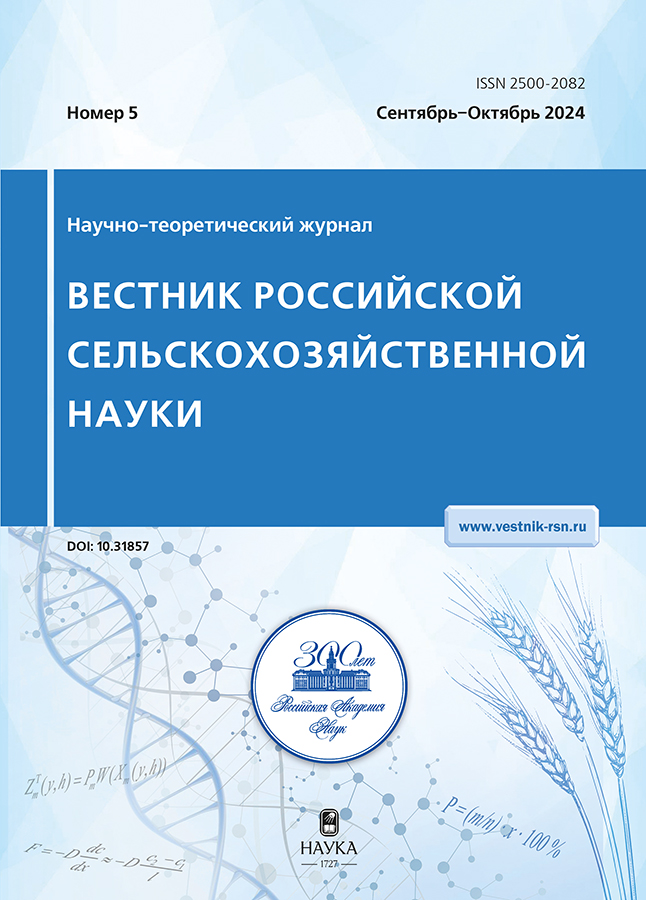Yield of winter soft wheat varieties of different ecological and geographical origin and their adaptability in the conditions of the Central Nonblack Earth Region
- Authors: Artyukhova O.A.1
-
Affiliations:
- The Institute of Seed Production and Agrotechnologies – branch of the FSBSI Federal Scientific Agroengineering Center VIM
- Issue: No 5 (2024)
- Pages: 4-7
- Section: Crop Production and Selection
- URL: https://vietnamjournal.ru/2500-2082/article/view/659237
- DOI: https://doi.org/10.31857/S2500208224050015
- EDN: https://elibrary.ru/zuggkk
- ID: 659237
Cite item
Abstract
When creating new varieties, it is necessary to pay attention not only to high yields and the quality of the original parent forms, but also to be guided by knowledge about their reaction to changing growing environment conditions. The article presents the results of a comprehensive assessment of 15 varieties of different ecological and geographical origin. The methods of S.A. Eberhart and W.A. Russell, A.A. Rossielle and J. Hamblin, L.A. Zhivotkov, E.D. Nettevich were used in the analysis of adaptability indicators. The research was carried out in the northwestern part of the Ryazan region in the fields of ISA – a branch of the Federal State Budgetary Educational Institution FNAC VIM in 2019–2023, of which two years were unfavorable – the index of environmental conditions (Ij) –2,54 – –1,87, three years favorable Ij was 0,84–2,24. It was found that, on average, over 5 years of research, the highest yield potential was possessed by the varieties of winter wheat Danaya – 5,79 t/ha, Isktar – 6,36 t/ha, Nebokrat and Slavna – 5,81 t/ha and 6,09 t/ha, which is higher than the average annual indicator by experience by 11,1%, 22,1%, 11,5% and 16,9%, respectively. The group of the most plastic varieties includes: Danaya and Lavina (Russia), Nebokrat and Slavna (Ukraine), Isztar (Germany). High responsiveness to improving environmental conditions was noted in winter wheat varieties Moskovskaya 39 (Russia) – 1,22, Fantasia (Belarus) – 1,23, Saturnus and Tambor (Germany) – 1,17 and 1,41, respectively. According to the complex of adaptive properties, the Isztar (Germany) and Nebokrat (Ukraine) varieties were distinguished as genetically flexible ((Ymin + Ymax)/2 from 5,56 to 6,26), with a high level of stability (PUSS from 103,28% to 113,12%), good adaptability to environmental conditions (KA – 1,15% and 1,26%, respectively) and resistance to stress ((Ymin – Ymax) from –4,23 to –4,68). The research results can be used in practical breeding.
Keywords
Full Text
About the authors
O. A. Artyukhova
The Institute of Seed Production and Agrotechnologies – branch of the FSBSI Federal Scientific Agroengineering Center VIM
Author for correspondence.
Email: podvyaze@bk.ru
Junior Researcher
Russian Federation, Podvyazye village, Ryazan regionReferences
- Bayanova O.V. Ekonometricheskoe issledovanie pokazatelej proizvodstva zernovoj produkcii v Rossijskoj Federacii // Modern Economy Success. 2020. № 1. S. 122–125.
- Buchnikov O.N., Dzhuha V.M., Gajduk V.I. i dr. Effektivnost’ funkcionirovaniya sel’skohozyajstvennogo biznesa v usloviyah sankcij: regional’nyj aspekt // Gumanitarnyj vestnik Donskogo gosudarstvennogo agrarnogo universiteta. 2022. № 2. S. 150–159.
- Gladysheva O.V., Bannikova M.I. Urozhajnost’ i ocenki adaptivnosti rannespelyh i pozdnespelyh sortov ozimoj myagkoj pshenicy v usloviyah Central’nogo Nechernozem’ya // Agrarnaya nauka. 2021. № 1. S. 129–132.
- Golovachev V.I. Metodika gosudarstvennogo sortoispytaniya sel’skohozyajstvennyh kul’tur / pod red. V.I. Golovacheva, E.V. Kirilovskoj. M.: Kolos, 1989. 267 s.
- Goncharenko A.A. Ob adaptivnosti i ekologicheskoj ustojchivosti sortov zernovyh kul’tur // Vestnik RASHN. 2005. № 6. S. 49–53.
- Zhivotkov L.A., Morozova Z.A., Sekutaeva L.I. Metodika vyyavleniya potencial’noj produktivnosti i «Urozhajnost’» // Selekciya i semenovodstvo. 1994. № 2. S. 3–6.
- Zhuchenko A.A. Ekologo-geneticheskie osnovy adaptivnoj sistemy selekcii rastenij // Sel’skohozyajstvennaya biblioteka. 2000. № 3. S. 3–29.
- Levakova O.V., Bannikova M.I. Analiz geneticheskih istochnikov cennyh priznakov sortov ozimoj myagkoj pshenicy v celyah sozdaniya iskhodnogo materiala // Agrarnaya nauka. 2019. № 7–8. S. 38–40.
- Levakova O.V. Izuchenie iskhodnogo materiala yarovogo yachmenya v celyah ispol’zovaniya ego v selekcionnom processe dlya Central’nogo regiona RF // Zernobobovye i krupyanye kul’tury. 2018. № 2 (26). S. 61–65.
- Nettevich E.D., Morgunov A.I., Maksimenko M.I. Povyshenie effektivnosti otbora yarovoj pshenicy na stabil’nost’, urozhajnost’ i kachestvo zerna // Vestnik sel’skohozyajstvennoj nauki. 1985. № 1. S. 66–73.
- Nettevich E.D. Selekciya i semenovodstvo yarovyh zernovyh kul’tur // Izbrannye trudy. M.; Nemchinovka: izd.-vo NIISH CRNZ, 2008. 348 s.
- Rahaev H.M., Bakkuev E.S., Eneeva M.N. i dr. Areal i povedenie centra zernovogo podkompleksa Rossii v 2000–2020 godah // Vestnik Rossijskoj sel’skohozyajstvennoj nauki. 2023. № 4. S.4–9.
- Rusanov I.A. Sovremennye sorta ozimoj pshenicy kak iskhodnyj material dlya selekcii v usloviyah lesostepi CChR: dis. kand. s-h. nauk: 06.01.05. Voronezh, 2004. 248 s.
- Filippov E.G., Bragin R.N., Doncov D.P. Analiz pokazatelej adaptivnosti sortov i linij yarovogo yachmenya v ekologicheskom sortoispytanii // Tavricheskij vestnik agrarnoj nauki. 2022. № 4 (32). S. 221–230.
- Eberhart S.A., Russell W.A. Stability parameters for comparing varieties // Crop Sci. 1966. № 6.
Supplementary files










